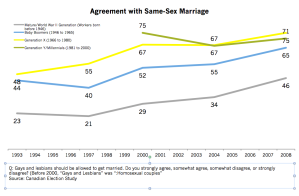Not too long ago, I wrote about the dramatic change in public opinion about same-sex marriage and our natural tendency is to think of these types of changes as being a reflection, to some degree, of generational replacement. Younger people have different attitudes than the previous generations and over time they become a larger proportion of the population. Generational replacement can be an easy explanation, especially when the change involves values because we have always been taught that values are the most enduring aspects of public opinion.
When it comes to same-sex marriage, Canada became more accepting/ more tolerant because Canadians changed their minds. Only a small percentage can be attributed to new generations entering into the adult population.
Some of the data analyzed goes back to 1993. This was a time, when less than one in five adults was a member of Generation X (born between 1966 and 1980). By 2011, Generation X accounts for 24% and a completely new generation, Y (born after 1980) represents 11% of adults. Since generation Y is very liberal on social issues, this could go a long way in explaining the trends.
Between 1993 and 2008, support for homosexual/ gay and lesbian marriage, as measured by the Canadian Election Study, rose from 37 to 64% (a massive change in level of agreement of 27 points). The chart which shows the evolution of public opinion in terms of four main generations indicates that:
- The oldest generation, born before 1946, remains the group most offside when it comes to same-sex marriage.
- It appears that generational replacement might be a significant part of the change as support for same-sex marriage among generation X and Y is flat or only increases marginally between 2000 and 2008.
- Clearly both older generations dramatically changed their views on the issue.
In fact, if the demographic makeup of Canada in 2008 was the same as it was in 1993, the support would be 61%. Replacement accounts for 3% of the change. The only qualifier is that the timing of the changes was different. Generation X was the first generation to move in a liberal direction followed by the Baby Boomers. Generation Y entered the public sphere with largely accommodating views on marriage.
Across an almost twenty year period, one would expect that generational replacement would account for much of the value change but the results here suggest that this simple explanation overlooks the significant changes in Canadian attitudes.
An examination of the other major trend line from the CES, feelings toward homosexuals/ gays and lesbians reveals similiar results.

